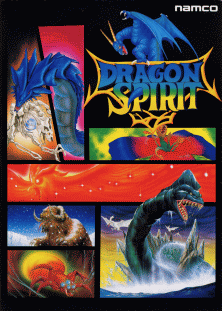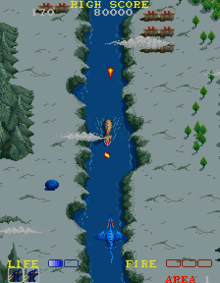Dragon Spirit
Dragon Spirit[lower-alpha 1] is a 1987 vertical-scrolling shooter arcade game developed and published by Namco. In North America, it was distributed by Atari Games. Controlling the dragon Amul, the player must complete each of the game's nine areas to rescue the princess Alicia from the demon Zawell. Similar to Namco's own Xevious, Amul has a projectile weapon for destroying air-based enemies and a bomb for destroying ground enemies. It ran on the Namco System 1 arcade board.
| Dragon Spirit | |
|---|---|
 Japanese promotional sales flyer. | |
| Developer(s) | Namco |
| Publisher(s) |
|
| Designer(s) | Tatsuya |
| Composer(s) | Shinji Hosoe |
| Series | Dragon Spirit |
| Platform(s) | Arcade, Amiga, Amstrad CPC, Atari ST, Commodore 64, TurboGrafx-16, Sharp X68000, ZX Spectrum |
| Release | |
| Genre(s) | Vertical-scrolling shooter |
| Mode(s) | Single-player, multiplayer (alternating turns) |
| Cabinet | Upright |
| Arcade system | Namco System 1 |
| CPU | 2 × 6809 @ 2.048 MHz 1 × 6809 @ 1.536 MHz 1 × HD63701 @ 1.536 MHz |
| Sound | 1x Yamaha YM2151 @ 3.57958 MHz, 1x Namco CUS30 @ 96 kHz, 1x DAC |
| Display | Vertical orientation, Raster, 224 x 288 resolution |
Music for the game was composed by Shinji Hosoe and designed by "Tatsuya". Hosoe, previously a graphics artist for Namco, was allowed to work on the music himself due to most of the company's composers working on Genpei Toma Den, however much of his work was accidentally wiped from the hardware midway through development and forced him to start over. Tatsuya previously created character artwork for Rolling Thunder, being assigned to the project after taking interest in the enemy designs. The game was dedicated to Shouichi Fukatani, a Namco programmer who had died a few years earlier in 1985 and worked on many of the company's older games, such as Dig Dug and Super Pac-Man.
The game was ported to several home systems, including the Sharp X68000, Atari ST and TurboGrafx-16, and is included in several Namco video game compilations. The arcade version of Dragon Spirit was met with positive reviews from critics for standing out amongst other shooter games, being praised for its Paleozoic setting, graphics and soundtrack. Home versions were met with a more mixed reception, being criticized for its high difficulty and inferior graphics and music. It was followed by two sequels, Dragon Spirit: The New Legend (1988) and Dragon Saber (1990). A ShiftyLook webcomic adaptation of the game was also produced.
Gameplay

Dragon Spirit is a vertical-scrolling shooter video game. The player controls the dragon Amul in his effort to rescue the princess Alicia from the serpent demon Zawell. Amul can move in eight directions and has access to two weapons; a flame projectile to destroy air-based enemies, and a bomb to destroy ground-stationed enemies, similar to Namco's Xevious series. Amur can take two hits before dying, indicated by a life bar at the bottom-left of the screen. Amur can use bombs to destroy eggs found on the ground of some stages, which will award one of two powerup items; a blue orb that will give Amul an extra head, granting him additional firepower, or an orange orb that will strengthen Amul's shots when three are collected.
The game features nine stages, which include large rivers, volcanoes, glaciers and jungles. Dying halfway through a stage will star the player at a checkpoint. At the end of each stage is a boss that Amul must fight in order to progress to the next stage. Amul can sometimes find special orbs throughout the game that can grant him additional abilities, such as a homing shot, a multi-shot, and the ability to shrink down in size to evade bullets. The game's opening cutscene shows Amur atop a mountain raising his sword in the air, with lightning striking it and transforming him into his dragon form.
Development and release
Dragon Spirit was released in Japan by Namco on June 20, 1987, later licensed to Atari Games for release in North America. The game's music was composed by Shinji Hosoe, originally a graphic designer for the company.[1] After asking Wonder Momo composer "Yudate" how to add music to the game code, he inserted many of his tracks during his own time — once the development team behind the game found out, he was automatically assigned as the game's composer.[1] During its development, Namco was low on composers as many of them went to work on Genpei Toma Den, allowing Hosoe to be able to compose the music himself.[1]
Graphics were created by "Tatsuya", who had previously produced character artwork for Rolling Thunder — after taking interest in the game's enemy designs, the team assigned him as the lead artist.[1] Tatsuya listened to Hosoe's music when he was low on ideas for enemy or background designs.[1] Hosoe's music was accidentally wiped from the hardware around midway through the development process, forcing him to start over again. After the first set of arcade boards were released, Hosoe remade the game's music in hopes it could be reused for a re-issue of the hardware, however his idea was scrapped by Namco due to high production costs.[1]
In North America and Europe, Dragon Spirit was ported to several home consoles and computers, including the Atari ST, Commodore 64, Amiga, ZX Spectrum and Amstrad CPC.[2] In Japan, Namco ported the game to the Sharp X68000 and PC-Engine, the latter being published in North America by NEC for the TurboGrafx-16.[2] Dragon Spirit is included in several Namco video game compilations, such as Namco Museum Vol. 5 (1997), Namco Museum 50th Anniversary (2005), Namco Museum Virtual Arcade (2008) and Namco Museum Essentials (2009). The TurboGrafx-16 conversion was digitally re-released onto the Wii Virtual Console in 2007, while the arcade version was released in 2009 exclusively in Japan. A version for Japanese mobile phones was released in 2003.
Reception
| Reception | ||||||||||||||||
|---|---|---|---|---|---|---|---|---|---|---|---|---|---|---|---|---|
| ||||||||||||||||
| ||||||||||||||||
Dragon Spirit was met with a positive response from critics, who praised its graphics, music and Paleozoic setting, and for standing out among other similar games during the time. In Japan, Game Machine listed the game on their July 15, 1987 issue as being the sixth most-successful table arcade unit of the year.[10]
Allgame praised its "gorgeous graphics" and soundtrack, and for being unique compared to other games of its genre,[3] while German magazine Power Play praised its interesting gameplay mechanics, notably the double-head powerup, and for its captivating gameplay.[8] Computer & Video Games praised the game's addictive gameplay and soundtrack, saying it lives up to games such as Galaxian and Galaga.[11] Japanese publication Gamest called it a "Namco shooting masterpiece" for its graphics, realism and soundtrack, awarding it the 5th "Grand Prize", 2nd "Best Ending" and 5th "Player Popularity" awards in 1998.[9] In a restrospective review, Hardcore Gaming 101 praised the game's graphics, challenging gameplay and iconic opening cutscene.[2]
Reviewing the TurboGrafx-16 conversion, IGN praised the game's vibrant graphics, unique setting and challenge, recommending the title to fans of Xevious and other similar vertical-scrolling shooters,[6] while Eurogamer liked its lack of a one-hit player kill and colorful visuals.[4] Nintendo Life was the most critical of the conversion, disliking its sudden difficulty spike towards the end and inferior quality compared to the arcade version. They also unfavorably compared it to Super Star Soldier, only recommending it to hardcore fans of the genre.[7] Famitsu awarded the PC-Engine port the "Gold Hall of Fame" award for its gameplay and strategy.[5]
Sequels and legacy
A sequel game, Dragon Spirit: The New Legend, was released for the Nintendo Entertainment System in 1989 and published outside Japan by Bandai. Taking place several years after the events of the original, it adds many of the levels from the arcade version alongside new stages, enemies, boss fights and cinematic cutscenes, alongside a brand-new storyline.[2] A second sequel Dragon Saber, was released for arcades in 1990 exclusively in Japan, running on the Namco System 2 arcade board. Subtitled After Story of Dragon Spirit, this game adds two-player co-operative play, charging shots and new enemy types. A PC-Engine version was released a year later in 1991, while the arcade version was released as part of the Japan-only Namco Museum Encore compilation. The PC-Engine conversion was released for the Japanese Wii Virtual Console in 2008, followed by the arcade version in 2009.
Amul appears as a playable character in the WonderSwan Color role-playing game Namco Super Wars, alongside Princess Alicia.[2] Several players in the Family Stadium series would be named after Amul and the game itself. In 2012, a webcomic adaptation of Dragon Spirit was created for ShiftyLook a subsidiary of Namco Bandai Games that focused on reviving older Namco game franchises for use in comics and animations.[12] Illustrated by artist Steve Cummings, the comic was a tongue'n cheek parody of the "damsel in distress" storyline used in fiction, featuring characters and settings taken from the arcade game. Nidia, a character from the webcomic, appeared as a character the player could date in the now-defunct browser game Namco High.
Notes
References
- "ドラゴンスピリット - 作曲担当: 細江慎治氏 & デザイン担当: tatsuya氏". Shooting Gameside (in Japanese). Vol. 6. Micro Magazine. 9 February 2013. pp. 16–19. ISBN 978-4896374100. (Translation by Shmuplations. Archived 2019-08-10 at the Wayback Machine).
- Kalata, Kurt (27 December 2011). "Dragon Spirit". Hardcore Gaming 101. Archived from the original on 22 March 2019. Retrieved 16 August 2019.
- Alan Weiss, Brett. "Dragon Spirit - Review". Allgame. Archived from the original on 15 November 2014. Retrieved 15 August 2019.
- Whitehead, Dan (7 July 2007). "Virtual Console Roundup". Eurogamer. Archived from the original on 19 February 2019. Retrieved 16 August 2019.
- "ドラゴンスピリット". Famitsu. Archived from the original on 17 May 2019. Retrieved 16 August 2019.
- M. Thomas, Lucas (5 July 2007). "Dragon Spirit Review". IGN. Archived from the original on 16 August 2019. Retrieved 16 August 2019.
- McFerran, Damien (1 July 2007). "Dragon Spirit Review (TG-16)". Nintendo Life. Archived from the original on 29 April 2019. Retrieved 15 August 2019.
- "Dragon Spirit". Power Play. April 1988. p. 96. Archived from the original on 15 August 2019. Retrieved 15 August 2019.
- 「ザ・ベストゲーム」『GAMEST MOOK Vol.112 ザ・ベストゲーム2 アーケードビデオゲーム26年の歴史』 (in Japanese) (5 ed.). Gamest. 17 January 1998. p. 78. ISBN 9784881994290.
- "Game Machine's Best Hit Games 25 - テーブル型TVゲーム機 (Table Videos)". Game Machine (in Japanese). No. 312. Amusement Press, Inc. 15 July 1987. p. 29.
- Edgely, Clare (September 1987). "Arcade Action - Dragon Split". Computer & Video Games. Archived from the original on 2 February 2019. Retrieved 16 August 2019.
- Carmichael, Stephanie (13 September 2012). "Katamari's Prince rises as a webcomic star". VentureBeat. Archived from the original on 27 July 2017. Retrieved 16 August 2019.